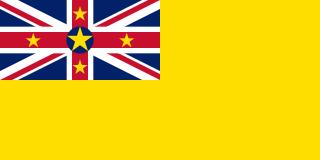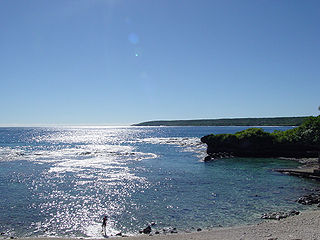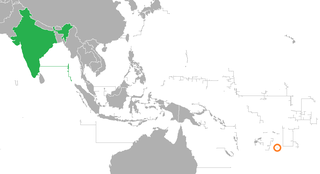
Niue is a self-governing island country in free association with New Zealand. It is situated in the South Pacific Ocean and is part of Polynesia, and predominantly inhabited by Polynesians. The island is commonly referred to as "The Rock", which comes from the traditional name "Rock of Polynesia".
The history of Niue is the history of the area and people of Niue, including its indigenous Polynesian societies. Niue was first settled by Polynesian sailors from Samoa in around 900 AD. Further settlers arrived from Tonga in the 16th century.

Niue is a small, oval island in the South Pacific Ocean, to the east of Tonga. It has an area of 260 square kilometres, and a coastline of 64 km. It claims an exclusive economic zone of 200 nautical miles, and a territorial sea of 12 nautical miles. It is one of world's largest coral islands.

Transport in Niue takes place on a road network, and via an (international) airport and a sea port.

The Realm of New Zealand is the area over which the monarch of New Zealand is head of state. The realm is not a federation but is a collection of states and territories united under its monarch. New Zealand is an independent and sovereign state that has one territorial claim in Antarctica, one dependent territory (Tokelau), and two associated states. The Realm of New Zealand encompasses the three autonomous jurisdictions of New Zealand, the Cook Islands, and Niue.

Severe Tropical Cyclone Heta was a Category 5 tropical cyclone that caused moderate damage to the islands of Tonga, Niue, and American Samoa during late December 2003 and early January 2004. Heta formed on December 25, 2003; it reached a maximum intensity of 260 km/h (160 mph) and an estimated pressure of 915 hPa before dissipating on January 11, 2004. It was the first named tropical cyclone to form during the 2003–04 South Pacific cyclone season.

Mutalau is one of the fourteen villages of Niue. Its population at the 2022 census was 77, down from 98 in 2017.

General elections were held in Niue on 7 June, 2008. They were initially expected to be held in April, but were delayed until June 2008. Niue has a 20-member legislative assembly, called the Niue Assembly, whose members are elected by approximately 600 registered voters. The assembly consists of 20 total members, 6 elected on a common roll and 14 representatives of the villages

The following outline is provided as an overview of and topical guide to Niue:

Sir Toke Tufukia Talagi was a Niuean politician, diplomat, and statesman. He served as Premier of Niue from 2008 to 2020.
Togia Likalika Sioneholo is a Niuean politician who was a cabinet minister of Toke Talagi's government from June 2008 to May 2011 after being elected to the Niue Assembly in the June 2008 general election. He was minister for community affairs, education, justice, shipping and bulk fuels. He was formerly chief electoral officer.

China-Niuean relations are relations between China and Niue.
Sam Pata Emani Tagelagi was a Niuean politician and elder. Tagelagi served as the first Speaker of the Niue Assembly from 1976 to 1993.

The political status of the Cook Islands and Niue is formally defined as being states in free association within the Realm of New Zealand, which is made up of the Cook Islands, Niue, and New Zealand and its territories, Tokelau and the Ross Dependency. The Cook Islands and Niue do not have full constitutional independence from New Zealand but act as independent countries. Some countries have recognised them as sovereign entities and established diplomatic relations. However, New Zealand may carry out defence and foreign affairs on behalf of the two associated states when requested.
Niue Hotel was a hotel in Niue, Oceania, the largest on the island. The government-owned hotel was built in 1975 in the hope of stimulating tourism. It was badly damaged in 1990, but was refurbished and expanded. However, it struggled to attract guests and in 2000 was put up for sale and leased for use as a medical school. The buildings were destroyed by a hurricane in 2004.

India–Niue relations are the bilateral relations between India and Niue.
Huanaki Cultural Centre & Museum was a national museum and cultural centre in Alofi in Niue, which was destroyed in 2004 by Cyclone Heta.

Tāoga Niue Museum is a national museum and cultural centre located in Alofi, Niue. It replaced the Huanaki Cultural Centre & Museum, which was destroyed by Cyclone Heta in 2004.













